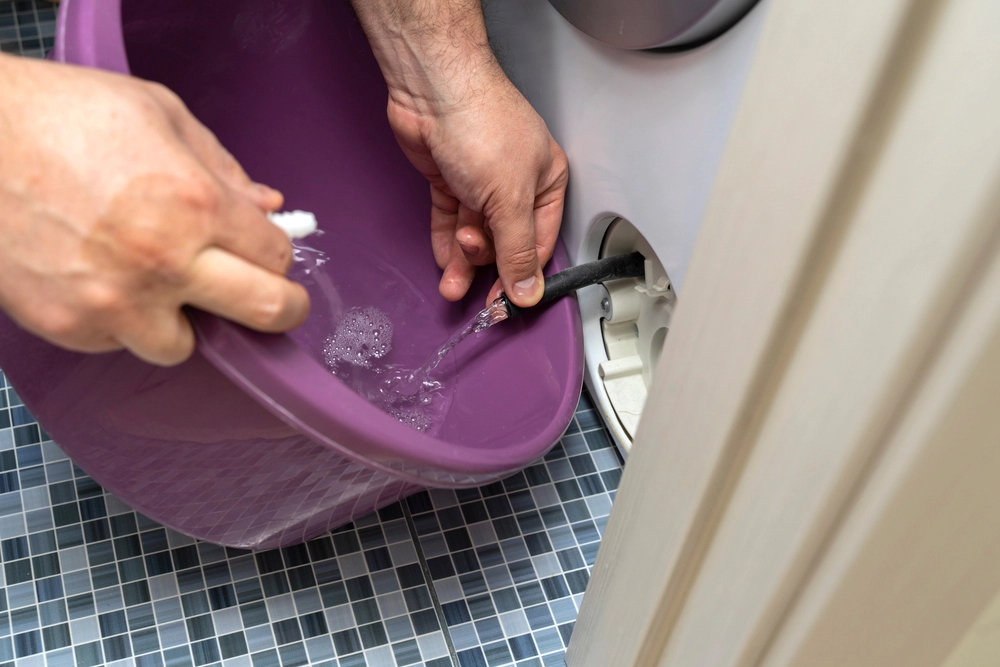
One of the questions many homeowners contend with at least once in their lifetime is how to drain water from washing machines. Like most home appliances, your washing machine is susceptible to complications. For instance, it may conk out and stop draining mid-cycle.
Most people face washing machine draining issues at some point, and it's not something you can downplay. Why? This problem encourages water to back up and eventually spill out of the machine. Fortunately, it's solvable.
This guide on how to drain water from washing machines will help you through the process of manually draining top-loading and front-loading devices and identifying the cause of the draining problem.
Draining Water from a Top-Loading Washing Machine
Before our handbook on how to drain water from washing machines kicks off, make sure you have the following tools and materials:
- A bucket (five-gallon is sufficient)
- Needle-nose pliers
- A screwdriver
- A plumber's snake
- A shallow container
- Towels
- The owner's manual
Additionally, ensure the lid of your top-loading washing machine is securely closed since it can only spin or drain with its lid locked in place. Once you've collected your tools and materials and made sure the lid is closed, you are ready to begin.
Step 1: Turn Off the Power
If your model has a power switch onboard its main frame, switch it off. You should unplug the machine from the power supply and fix the power cord to avoid interference or destruction during the project.
We offer emergency plumbing services at Mr. Rooter Plumbing, so if you ever feel unsure about DIY, we are ready to assist you!
Step 2: Find the Drain Hose
The drain hose is typically found at the back of the unit. You may need to pull the washer away from the wall to have better access to the hose and lay down some towels in case of spillage.
The drain hose is usually colored gray, while the hot and cold-water inlet hoses are typically red and blue, respectively. As a precaution, turn off the two supply hoses (red and blue) for hot and cold water.
Step 3: Drain the Water
With towels on the floor, disconnect the drain hose (gray pipe) and hold it up so water doesn't spill. Lower the drain hose carefully into a bucket and wait till your bucket is full.
Hold the drain hose back up when your bucket is full and pour out the bucket water. Repeat this until your washing machine's drum is empty.
If at any point you feel overwhelmed, that is okay. Mr. Rooter Plumbing offers clogged drain repair to help diagnose and solve the problem.
Draining Water from a Front-Loading Washing Machine
If your query on how to drain washing machines is based on a faulty front-loading piece of equipment, the following process may help:
Step 1: Switch Off and Unplug the Washing Machine for Safety
If the machine is wired into your house's electrical circuit, switch off the circuit at the appropriate circuit breaker.
Step 2: Find the Drain Hose
Front-loading washing machines either feature a single drain-pipe filter or a drain-pipe filter with a separate drain hose. Since it's typically found in a panel at the bottom of the front face of your washing machine, you'll likely need a screwdriver to access it.
It is always advisable to consult the manual first for easy, problem-free operation.
Step 3: Drain the Water
If your machine features a drain pipe filter, place a shallow container directly under the filter to hold the water.
Turn the drainage knob on slowly and let the container fill with water, then turn it off and drain the water into a basin or sink. Repeat this until the washer is completely drained.
If your washer uses a drain pump filter and detachable drain pipe, unhook the draining tube, then unscrew the cap to drain the water.
Step 4: Clean the Filter
Scrub the filter lightly using a soft-bristled brush and remove any visible debris by hand. Rinse with warm water and replace it in its original position.
What's Causing the Draining Problem?
After draining the washing machine, it is time to investigate the issue causing drainage problems. Typical culprits include:
- A drain hose clogs: If water doesn't rush out after lowering the drain pipe into the bucket, then the hose is likely clogged. A plumber's snake is very helpful in removing such blockages.
- Drain pump clogs: These are often trickier to fix. Consult your owner's manual to know exactly where the drain pump is located (typically behind a removable panel). Use your needle-nose pliers to remove any clogs in the pump.
- Using the correct amount of detergent: Make sure you use the correct amount. Too much causes residue inside your unit and the drain line.
Contact Mr. Rooter Plumbing of Phoenix
With over three decades of plumbing experience, we at Mr. Rooter Plumbing of Phoenix have mastered the art of appliance repair and maintenance, drain cleaning, sewer repair, and much more. So, we are the answer to all your questions, including how to drain water from washing machines.
If you reside in Phoenix, AZ, or its neighborhoods, do not hesitate to contact our repair, maintenance, or inspection professionals or request an estimate today.
